Research Projects
→ To view my web development projects, visit my portfolio at komasurfer.com.
Meta-HCI: Meta-Research in HCI
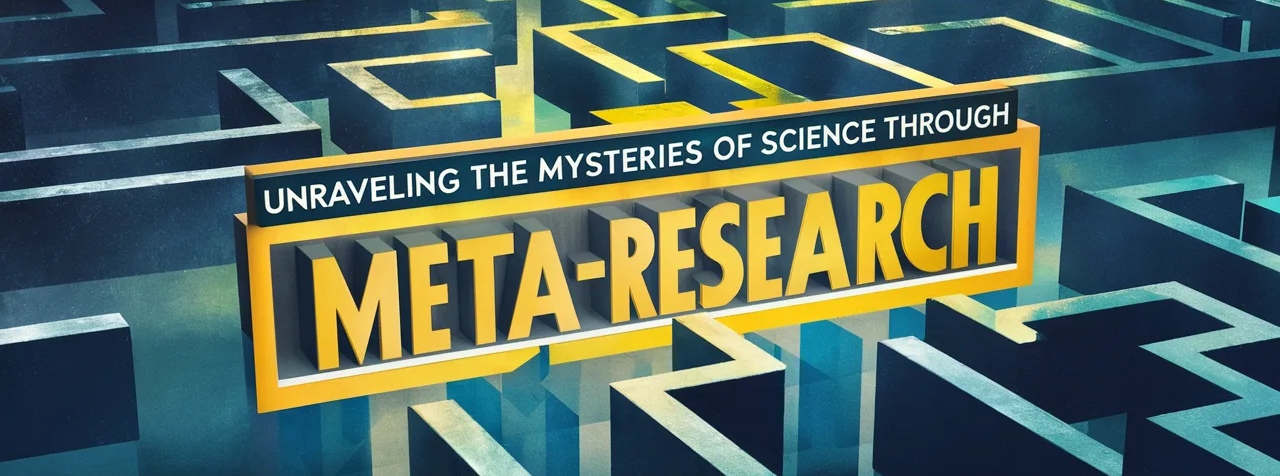
Prompt Engineering for Text-to-image Generation

Text-to-image generation with deep generative models has made giant leaps towards becoming a mainstream phenomenon since OpenAI's introduction of the multimodal CLIP model in 2021. This explosion of interest was facilitated by the availability of executable notebooks on Google's Colaboratory in which non-expert users can execute machine learning models for free and without deep knowledge of programming. Users on Google Colab interact with generative models via input prompts. Prompts are short texts that describe the expected end result, such as "a beautiful painting of a landscape". The online community that quickly emerged around this novel way of synthesizing artworks found that the quality of the generated artworks can be increased by using so-called prompt modifiers in the input prompt, such as "trending on artstation" or "rendered by Unreal Engine". 'Prompt engineering' or 'prompting' refers to the practice and skill of finding effective input prompts for a text-to-image model.
This project investigates 1) the skill and practice of prompt engineering, 2) the emerging AI art community, and 3) the specific input prompts and modifiers used in this community.
The project received funding in form of a research grant by the University of Jyväskylä.
Presentations / Articles
Prompting for X

Presentations / Articles
Crowd Feedback Systems
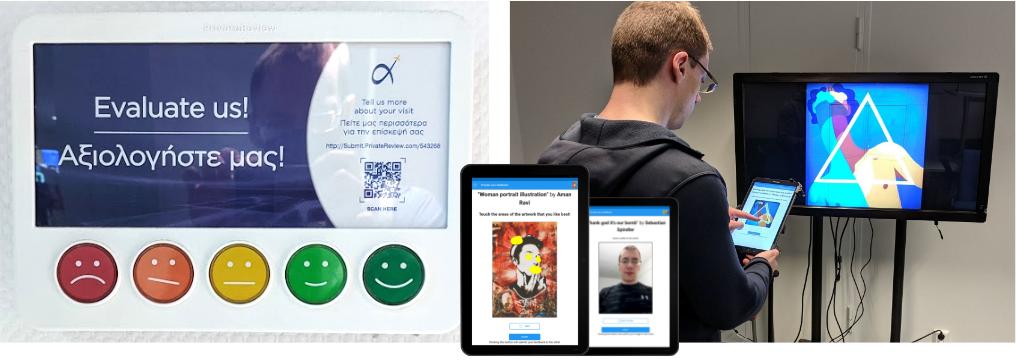
Feedback systems have become ubiquitous. You can find them in many public places, such as airports and restrooms. With these systems, people typically can give feedback using color-coded buttons with smiley faces on a scale from left (good) to right (bad). Feedback is provided in response to a prompt, such as "How do you rate the cleanliness of this restroom?" or "How do you rate your experience?".
During my PhD, I became interested in eliciting more complex feedback from situated and online crowds. For instance, I created a systems to elicit feedback for digital artworks on a public display and I created CrowdUI, a system in which users can manipulate a web page and send the altered page as feedback to the web designer.
The project was funded by the Center for Ubiquitous Computing at the University of Oulu, Finland.
Presentations / Articles
CPCW – Crowd-Powered Creative Work

Creativity is the process that leads to an artefact deemed both novel and useful in a given context and timeframe. Supporting creativity is considered as one of the grand challenges in HCI and inherently exploratory and transdisciplinary. Machines fall short in the fundamental characteristics that humans excel in — recombination, analogical transfer and divergent thinking. As machines cannot match the human intelligence when it comes to creativity, applying crowd-powered creativity support tools is an underexplored and promising area of research. As the World Wide Web has thoroughly permeated our work practices, supporting creative work with the crowd has become feasible. Microtasks are fast to complete, incur a low cognitive load and require little expertise. Crowdsourcing is especially effective in situations that require human cognition and judgement for optimal decision-making, such as creative work. Moreover, creativity is a social process. Studies from psychology show that groups of people with diverse backgrounds provide high quality ideas and can outperform skilled experts. Crowds offer this diverse set of skills because they are heterogeneous, providing different contexts and backgrounds leading to diverse ideas. Situated and mobile crowdsourcing further allows to tap into a local crowd with specialized knowledge.
This research project will explore challenges in regard to supporting creative work with the crowd. Of the eight creative activities suggested by Shneiderman, the majority of creativity support tools focus only on the ideation phase. This thesis aims to support a number of creative activities other than ideation, such as consulting with peers, dissemination, and searching. Some of the research questions investigated in this thesis are:
- Can structured judgements from non-experts support complex creative work?
- How can the quality of crowdsourcing results be assessed?
- What incentives could be given to crowdworkers to participate in creative tasks?
- What is the best context conducive for supporting creative work?
- What context do we need to provide in the tasks for the crowd (priming)?
- What forms of collaboration are useful and helpful in crowd settings?
- How will AI and human agents collaborate in complex creative tasks?
We will address these questions using a systems development approach, validated in several use case studies. We will design, implement and evaluate a socio-technical system to support creative work with the crowd. We will deploy and evaluate this system on the campus of the University of Oulu. The system’s core will be a general purpose crowdsourcing platform that can support a variety of different tasks. While crowdsourcing platforms often are built for a specific purpose, we aim to create a solution that can support generic user-defined tasks, essentially forming a user-configurable social machine. One of the research questions will explore how and for what purpose users will use the system for.
The project was funded by the Center for Ubiquitous Computing at the University of Oulu, Finland.
Presentations / Articles
Workshops
NFDI4Culture – Consortium for research data on material and immaterial cultural heritage
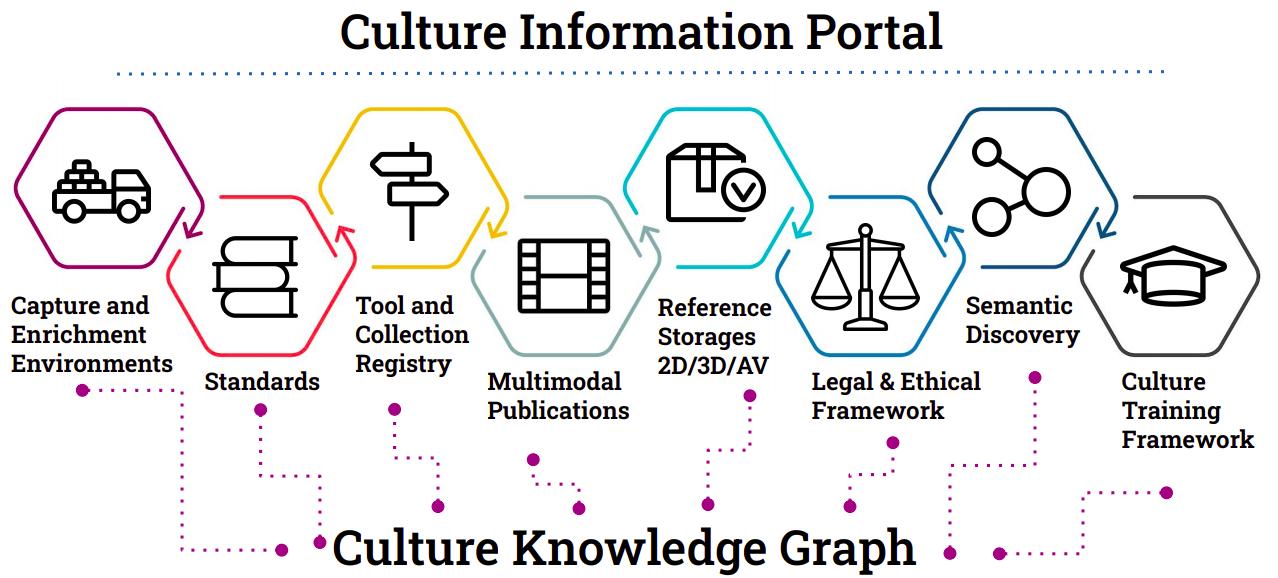
Responsible for the design, implementation, population, and management of the NFDI4Culture knowledge graph as part of the NFDI4Culture initiative on research data infrastructures for material and immaterial cultural heritage in Germany.
The project was funded by the German Research Foundation (Deutsche Forschungsgemeinschaft / DFG) #441958017
Folk Theories for a Better Understanding of Human-AI Interaction

Folk theories represent the users' beliefs of how an AI-driven system works. Prior research has investigated folk theories as a lens on users' reasoning about the algorithmically-curated content of news feeds on social media platforms, primarily in interview studies and surveys. In this project, we research and develop interactive interfaces for the structured capturing and crowdsourced collection of folk theories at scale.
An understanding of how users reason about algorithmically-curated content could provide valuable insights into how web-based systems can be designed for fairness, accountability, and transparency. These three constituents contribute towards increased awareness and understanding of AI decisions, and could be a step stone to support the formation of trusting social relationships with Artificial Intelligence.
The project received funding from the Nokia Foundation, Finnish Foundation for Technology, Jenny and Antti Wihuri Foundation, Tauno Tönning Foundation, and the Riitta and Jorma J. Takanen Foundation.
Presentations / Articles
CrowdUI – Supporting Web Design with the Crowd
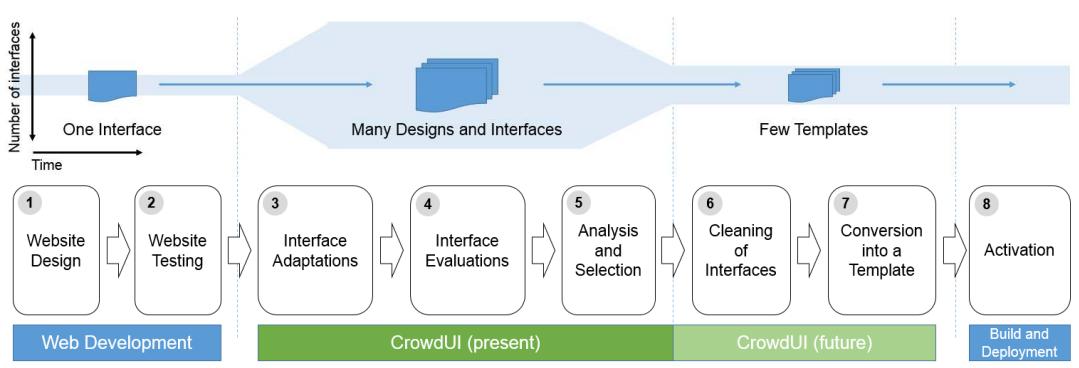
CrowdUI is the prototype of a tool that enables the members of the community of a website to re-arrange any parts of the website's user interface (UI) and thus provide suggestions to the Web designer. The interface modifications are peer-evaluated by the members of the community of users. The integrated pre- and post-task survey can flexibly be adapted to different usability measurement instruments. A comprehensive survey of usability measurement methods was also part of this Master thesis.
The tool was tested in a field study (140+ users completing phase 1 and 45 users completing the full survey). In total, 62 UI adaptations were sourced, of which 15 received usability ratings. The work also included a new method of ranking and selecting items from a pool of rated UI adaptations.
Presentations / Articles
IKON – Knowledge Transfer Concept for Research Content, Methods, and Competencies in Research Museums
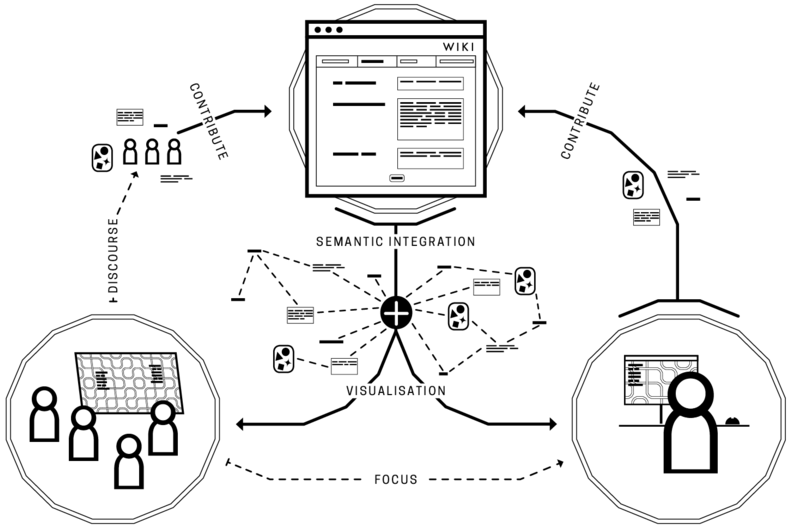
At the Natural History Museum in Berlin, researchers from disciplines such as biology, paleontology, mineralogy and information science work on manifold projects in a multidisciplinary research setting. This project, funded by the German Federal Ministry of Education and Research, grant 03IO1633, aims to identify opportunities for inner-organisational transfer of knowledge, competencies, and methods. A formal ontology is developed to support this endeavor.
The project aims to provide the researchers at the museum with (1) wiki-based read and write access to research project information, (2) insights about potentials for knowledge transfer powered by linked data and (3) interactive visualisations of these networked sources of knowledge. Focussing on the seamless integration of these provisions, the project aims to set up an actionable and holistic system that visualises research project data and their potential for knowledge transfer in research museums.
The project was funded by the Ministry of Education and Research (BMBF).
Medium
Presentations / Articles
Workshops
Crowdsourced Ontology Engineering

Ontology engineering has evolved from a practice that was traditionally conducted by knowledge engineers together with domain experts towards more agile approaches that involve non-experts and end users.
This project focused on involving end users in the co-creation of an ontology via a novel crowdsourcing-based method for ontology engineering embedded in the larger socio-technical context of the project at the Museum of Natural History in Berlin.
ID+Lab

The aim of the ID+Lab project is to make the interdisciplinary nature of the Cluster "Image Knowledge Gestaltung" accessible by raising awareness for existing collaborative work. Via the provision of an interactive visualization of the interdisciplinary research activities, members of the cluster can explore relations concerning research topics, research objects, used methods, research activities and publications.
The project consists of three parts - a modelling method, a modelling application and an 'enhanced publication' platform for the publication of interdisciplinary research projects. The underlying idea is that scientists can gain insights about their work through modelling: new connecting points are made explicit, showing further development possibilities for research projects and collaborations.
SkillsPlanner

Ethos SkillsPlanner was a £1.3 million project envisioned to reduce the skills shortage in the UK’s construction industry. Partly funded by Innovate UK, the linked open data based platform aimed to integrate and interpret data generated from sources provided by industry project partners in the UK such as Crossrail, Tideway, and High Speed 2. The project partners self-dependently uploaded their data into the central CKAN storage. On upload, a series of data management tools executed the conversion into semantic web data formats and published selected data from the staging environment to the public server. The tools interacted with the CKAN storage and the linked data platform via a RESTful API.
My role in this project was to develop the backend infrastructure and related data management and conversion tools. Further tasks were the documentation of the infrastructure, design and implementation of visualisations and pivot table components based on the Data Cube vocabulary, functional improvement of the MakeRDF tool, and the re-design, re-factoring, and documentation of the SameAs-Lite co-reference resolution service.
Anwendung des Kano-Modells zur Analyse und Charakterisierung gesellschaftlicher Anforderungen an Produkte
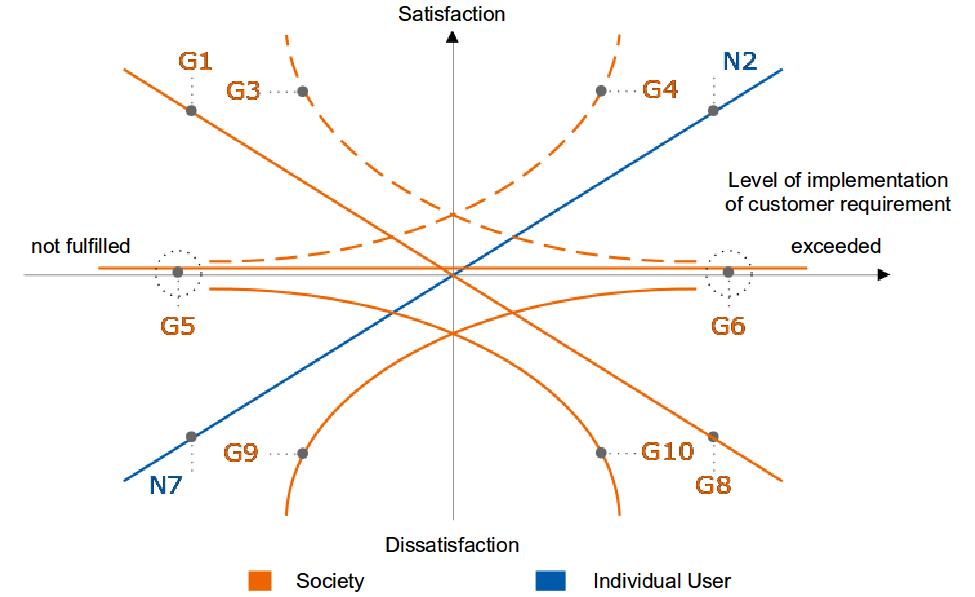
Das Modell von Kano ist eines bedeutendsten und gleichsam einfachsten Modelle zur Erklärung von Produkteigenschaften und Produktanforderungen. Kano betrachtete drei Arten von Attributen (Basis-, Leistungs- und Begeisterungsfaktoren), die zur Zufriedenheit (oder Unzufriedenheit) mit einem Produkt beitragen. Die Attribute werden dabei aus Sicht eines einzelnen Kunden klassifiziert. Diese Klassifikation der Attribute kann sich von Person zu Person unterscheiden. Auch verändert sich die Wahrnehmung der Attribute bzw. Produktanforderungen im Laufe der Zeit. Man denke nur an das iPhone, dessen Charakteristiken bei der Ersteinführung in den Mobiltelefonmarkt Begeisterung hervorriefen, mittlerweile jedoch zum Standard geworden sind.
Unterstützt durch eine Literaturrecherche zum Kano-Modell wurde in dieser theoretischen Diplomarbeit untersucht, wie sich die Anforderungen der einzelnen Person an ein Produkt von den Anforderungen der gesamten Gesellschaft unterscheiden. Hierbei wurde die Gesellschaft als ein repräsentativer Nutzer modelliert. Durch systematische Variation und Diskussion der Produktanforderungen ergab sich eine Charakterisierung der gesellschaftlichen Produktanforderungen nach zeitlicher Stabilität, Universalität und Immaterialität des Anforderungsobjekts. Es konnte ausserdem gezeigt werden, dass sich gesellschaftliche Produktanforderungen im Kano-Modell nicht notwendigerweise spiegelverkehrt zu den Anforderungen der einzelnen Person verhalten.
Presentations / Articles
Business Concept for a Social Network based on Peer-to-Peer Technology
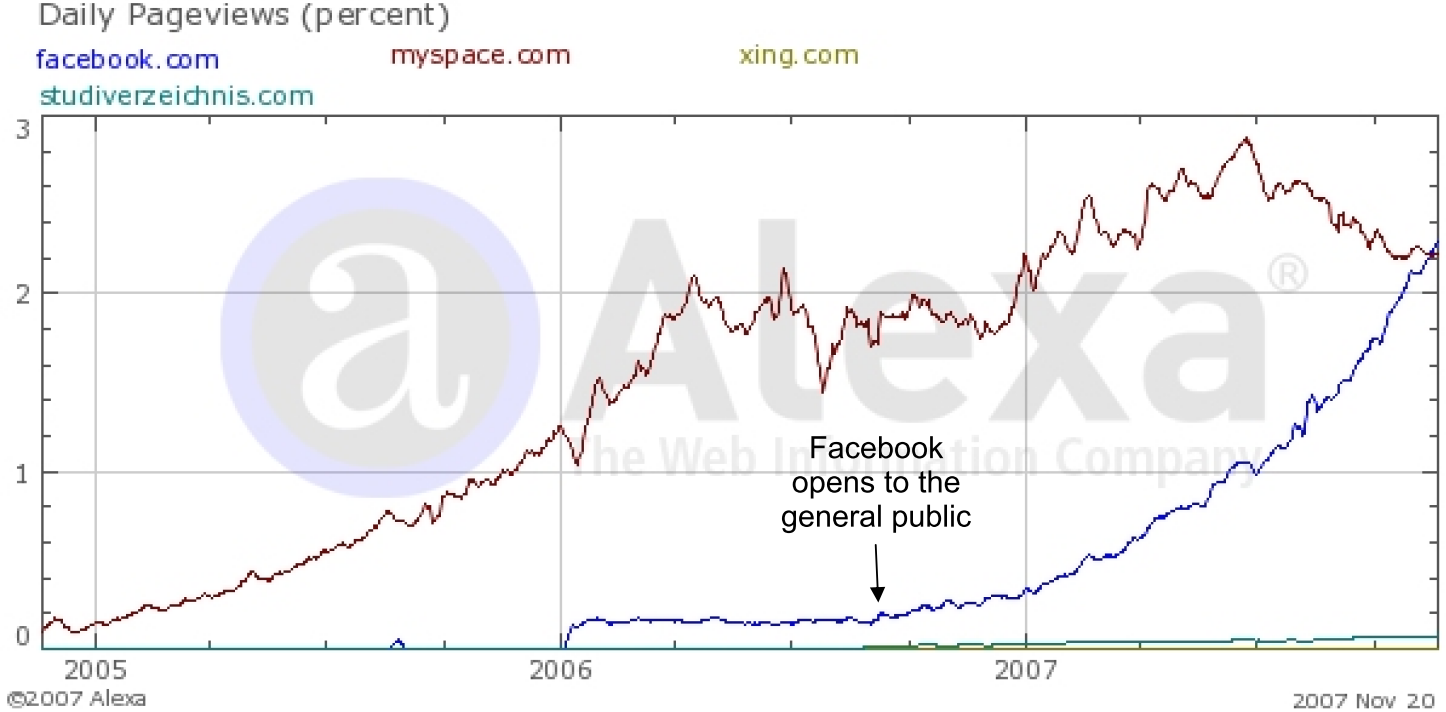
Amidst the raging battle of the big social networks at the time (MySpace and Facebook), the KOM Multimedia Lab commissioned a student research project to investigate the possibilities for launching a new type of social network based on peer-to-peer technology. The seminal paper was sponsored by the Dr.-Otto-Röhm endowed chair for Entrepreneurship (Prof. Dr. Geschka).
The project empirically investigated a number of important entrepreneurial decisions: How to make money as a social network startup company? What are the competitors’ strategies? What should be offered to the users? How to reach the critical mass of users? The study was conducted in the form of an empirical survey (n=247), including an analysis of product features with a Conjoint Analysis. While we know today who won the race for the dominance of social networks (the winner takes all), the project's final presentation contains some important and interesting contemporary quotes and graphs from this exciting time of early social networks.
Presentations / Articles
Entwicklung einer XML-basierten Beschreibungssprache für Produktentwicklungsinhalte
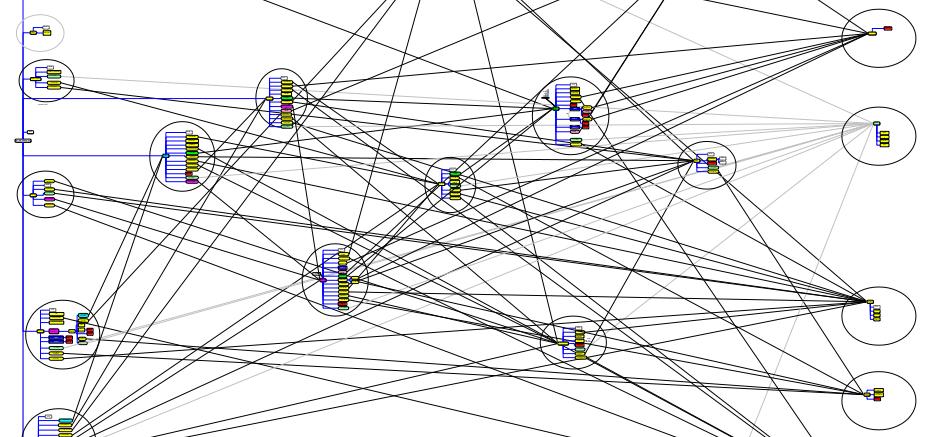
Zu den Grundaufgaben von Universitäten gehört die Lehre, und damit auch die Erstellung von Lernmaterialien und Vermittlung von Wissen. Im Zuge der sich verstärkenden Vernetzung und der mit dem Internet verbundenen Möglichkeiten wird der Einsatz digitaler Lehr- und Lernmaterialien an Bedeutung zunehmen. Um Inhalte digital verfügbar zu machen, bedarf es einer Interpretation der Lehrmaterialien. Erst durch die Beschreibung der Struktur und Bedeutung der Daten kann eine Weiterverarbeitung vorgenommen werden.
Ziel dieser Arbeit war die Entwicklung einer Beschreibungssprache für Wissen aus dem Bereich der Produktentwicklung (PE). Als Ausgangsbasis diente eine intensive Analyse der Inhaltsarten der Produktentwicklung. Die Inhalte der PE wurden klassifiziert und in ein allgemeingültiges Schema übersetzt. Die zu entwickelnde Beschreibungssprache sollte vor allem im Bereich der universitären Lehre zur Anwendung kommen. Jedoch sind auch andere Benutzergruppen denkbar, wie beispielsweise Produktentwickler in Unternehmen. Die Anforderungen, die sich aus dieser Zielsetzung ergeben, machen deutlich, dass ein modularer Aufbau der Inhaltseinheiten die bestmöglichen Resultate zeigt. Verteilt gespeicherte Einheiten erlauben nicht nur die einfache Aktualisierung von Inhalten, sondern auch die situationsbedingte Präsentation der Inhalte beim Benutzer in verschiedenen Formaten.